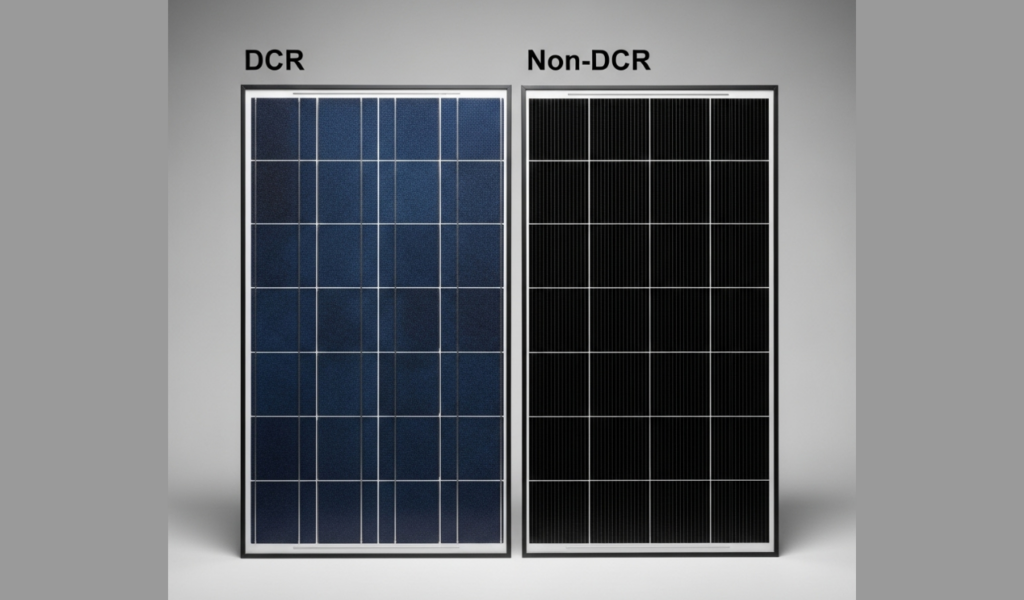Why opt for DCR or Non-DCR Solar Panels

As India’s rooftop solar sector and available products continue to expand, selecting the right panels can feel like a maze! While there are several types of panels based on its manufacturing and technology, the Government of India also distinguishes solar panels based on their location of manufacturing. This becomes important when you want to avail government schemes and subsidies. Under DCR (Domestic Content Requirement), panels must be manufactured in India, while Non-DCR panels can be imported. Understanding these differences is important for both consumers and installers. This guide delves into their technical performance & economic viability of both types of panels.
What is DCR?
DCR mandates the use of domestically manufactured solar panels and cells in specific government-backed solar projects. Introduced under the Jawaharlal Nehru National Solar Mission (JNNSM) in 2010, the DCR aims to bolster local manufacturing, reduce import dependence, and enhance energy security. While the World Trade Organization ruled against the DCR policy in 2016 for certain projects, it remains applicable to government-supported schemes such as:
- PM-KUSUM (for agricultural applications)
- PM-Surya Ghar: Muft Bijli Yojana (for residential installations)
Under these schemes for agricultural support and domestic applications, using DCR-compliant panels is a prerequisite for availing government subsidies.
The Approved List of Models and Manufacturers (ALMM), established by the Ministry of New and Renewable Energy (MNRE) in 2019, ensures that only verified and high-quality solar modules are used in government-supported projects. As of April 1, 2024, the ALMM mandate was reinstated after a temporary suspension, making it compulsory for both subsidized and unsubsidized rooftop projects to use ALMM-listed modules.
Furthermore, starting June 1, 2026, projects under government schemes will be required to use solar PV modules made from ALMM-listed cells, emphasizing the government’s push towards comprehensive quality assurance in the solar sector.
Comparing DCR and Non-DCR
Technical Comparison
1. Performance & Efficiency
DCR Panels: Made in India, these panels are suitable for local use and generally provide stable long-term performance. Their efficiency may be slightly lower since not all domestic manufacturers use the latest global technologies.
Non-DCR Panels: These panels typically offer higher efficiency due to advanced technologies used by global manufacturers. However, as many are imported, long-term performance may vary depending on product quality.
Economic Comparison
1. Cost per Watt
DCR Panels: Pricier, ranging between ₹24–₹26 per watt, influenced by domestic manufacturing costs and recent anti-dumping duties.
Non-DCR Panels: More affordable, with prices around ₹15 per watt .
2. Subsidy Eligibility
DCR Panels: Eligible for government subsidies under schemes like PM Surya Ghar and PM-KUSUM, potentially covering up to 40% of installation costs.
Non-DCR Panels: Not eligible for these subsidies, which can impact overall affordability despite lower upfront costs.
In taking an example of a 3kW rooftop solar system, the cost comparisons are as follows
DCR System: Approximately ₹1,80,000 total installation cost ; after a ₹78,000 subsidy, net cost is around ₹1,02,000.
Non-DCR System: Approximately ₹1,50,000 total installation cost; no subsidy available.
3. Payback Period
DCR Panels: With subsidies, the payback period is typically 1-2 years.
Non-DCR Panels: Without subsidies, the payback period may extend beyond 3-4 years, depending on energy savings and local electricity rates.
Accessibility & Availability
DCR Panels: While accessible through local suppliers and online platforms, availability may be limited due to domestic manufacturing constraints.
Non-DCR Panels: Readily accessible through various channels such as local suppliers and online marketplaces, with generally fewer supply constraints.
|
Aspect |
DCR Panels |
Non-DCR Panels |
|
Performance & Efficiency |
Designed to suit local conditions; may have lower efficiency |
Designed for global use; advanced technology may offer higher efficiency |
|
Cost per Watt |
₹24–₹26 per watt. |
Around ₹13 per watt. |
|
Subsidy Eligibility |
Eligible for subsidies under PM Surya Ghar, PM-KUSUM (up to 40%, ₹78,000 ). |
Not eligible. |
|
System Cost |
Approximately ₹1,80,000 as total installation cost |
Approximately ₹1,50,000 as total installation cost |
|
Payback Period |
1-2 years |
> 3 years |
|
Accessibility |
Consumers can access it through different sources like local suppliers and online options Local Suppliers and online
|
Consumers can access it through different sources like local suppliers and online options Local Suppliers and online
|
|
Availability |
Depends on local manufacturing capacity as per local manufacturing capacity
|
Readily available through avenues discussed under accessibility as per accessibility |
Conclusion
Opt for DCR Panels if you aim to leverage government subsidies. In the case of PM Surya Ghar Yojana this is beneficial for a system of up to 10kW for domestic consumers. Be mindful of potential supply constraints that can sometimes arise with DCR modules due to limited manufacturing potential. You may, however, prefer Non-DCR Panels if immediate installation is your priority or if you are looking to install the system at a commercial or industrial unit.

Staying informed about policy changes, such as the ALMM mandates, is essential for making the best choice for your rooftop solar installation.

rameswer agro mashinry sales
September 11, 2025 at 12:09 pmmy ferme is rameswer agro masinry sales rampur road shahabad up aap syestem ke bare me jankary de